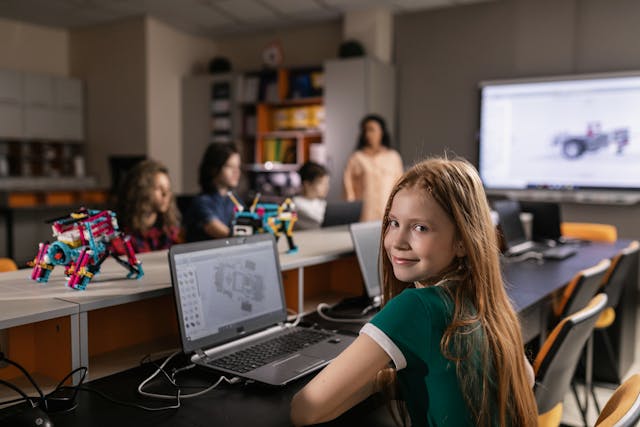- Robotics clubs and competitions enhance students’ engagement and interest in STEM, making these subjects more accessible and appealing through practical application.
- Participation in robotics is vital preparation for careers in technology and engineering, which are expected to grow significantly in the future.
- Beyond academic benefits, robotics fosters important social and emotional skills through teamwork and collaboration, enhancing students’ sense of community and respect.
- Robotics education significantly contributes to adolescent learning and development, preparing students to thrive in a technologically advanced world with creativity and confidence.
Incorporating robotics into learning environments in the rapidly evolving education landscape represents a dynamic and influential approach to engaging young minds in Science, Technology, Engineering, and Mathematics (STEM). This engagement not only nurtures curiosity and innovation but also prepares students for the technological frontiers of the future. This blog post seeks to unpack the multifaceted impacts of robotics clubs and competitions on adolescent learning, offering insights for educators, parents, and enthusiasts alike.
The Role of Robotics in STEM Education
Integrating robotics in educational curricula is becoming increasingly prevalent, reflecting a broader shift towards immersive, experiential learning methodologies. Robotics, by its very nature, requires an interdisciplinary approach encompassing all facets of STEM, thus providing students with a holistic understanding of how theoretical knowledge applies in real-world scenarios.
Reputable high schools with STEM programs often leverage robotics clubs and competitions as practical extensions of classroom learning. These extracurricular activities offer hands-on experience with engineering concepts, coding, and problem-solving, enhancing the traditional educational experience significantly.

Benefits of Joining Robotics Clubs and Competitions
Participation in robotics clubs and competitions yields numerous educational benefits, chief among them being:
Cognitive Skill Development and Problem-Solving
Robotics challenges students to rigorously apply logic and critical thinking skills, fostering a mindset geared towards efficient problem-solving and analytical thinking.
Creativity and Innovation
Design challenges in robotics compel students to think creatively, pushing the boundaries of innovation as they seek to conceptualize, design, and build functional robots.
Collaboration and Teamwork
Robotics is inherently a collaborative endeavor. Students learn to work effectively in teams, honing communication and interpersonal skills essential for success in both academic and professional settings.
Challenges and Solutions in Implementing Robotics Programs
Despite their clear benefits, integrating robotics programs into educational systems is not without hurdles. Financial constraints, access to resources, and teacher preparedness represent significant challenges. However, innovative funding models, community partnerships, and professional development initiatives are proving effective in overcoming these obstacles, enabling more schools to incorporate robotics into their STEM offerings.
Impact on Adolescent Learning and Development
The infusion of robotics clubs and competitions into the educational milieu profoundly impacts students’ engagement and enthusiasm for STEM subjects. By providing a tangible application for classroom theories, robotics makes STEM disciplines more accessible and appealing, fostering a deeper, sustained interest in these fields.

Furthermore, participation in robotics is an invaluable preparatory stage for students considering future careers in technology and engineering – sectors poised for continued growth. Beyond the cognitive and career benefits, robotics also plays a crucial role in students’ social and emotional development. The teamwork and collaboration required in robotics competitions cultivate community and mutual respect among participants, nurturing essential life skills that extend beyond the classroom.
Discussing Future Directions
The future of robotics in education appears boundless, with potential advancements and enhancements shaping how students learn and interact with technology. The focus is on refining the integration of robotics within current educational frameworks and exploring innovative approaches that redefine the learning experience. Anticipating advancements in artificial intelligence and machine learning, educators and technologists collaborate to create more intuitive and interactive robotics programs.
These future iterations aim to further personalize learning, adapt to individual student needs, and even predict learning outcomes, revolutionizing the educational landscape. The ongoing dialogue between educators, policymakers, and technologists is crucial in navigating the challenges and opportunities that lie ahead, ensuring that robotics education continues to evolve in alignment with broader educational goals and societal needs.
Expanding the Horizon of Robotics Education
Expanding the horizon of robotics education involves integrating more sophisticated technologies and ensuring accessibility and inclusivity across diverse student populations. This forward-looking approach means bringing robotics into classrooms in underrepresented communities and adapting curricula to meet a variety of learning styles and needs.
It also entails promoting gender diversity in STEM fields by encouraging more girls and non-binary students to engage in robotics from an early age. By fostering an environment where all students feel welcome and represented, we can harness the full potential of robotics education to inspire a new generation of innovators and problem solvers.
The goal is to democratize access to robotics, making it a pivotal aspect of education for every student, regardless of background, geographical location, or economic status. This inclusive strategy will not only broaden the talent pool in STEM fields but also ensure that the future of technology development is shaped by diverse perspectives, enhancing creativity and innovation.
Conclusion
The role of robotics clubs and competitions in enhancing adolescent learning and development cannot be overstated. These activities bolster STEM education and equip students with the skills, confidence, and creativity needed to thrive in an increasingly technologically driven world. The call to action for educators, policymakers, and communities is clear: Invest in and support robotics education initiatives. By doing so, we can ensure that the next generation is capable of navigating the challenges of the future and equipped to innovate and lead in the face of them.

